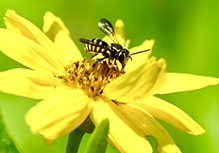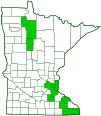Say’s sunflower burrowing-resin bee
(Paranthidium jugatorium jugatorium)
Conservation • Description • Habitat • Ecology • Distribution • Taxonomy
Conservation Status |
|
|||||||
| IUCN Red List | not listed |
|||||||
| NatureServe | NNR - Unranked SNR - Unranked |
|||||||
| Minnesota | not listed |
|||||||
Description |
||
There are four subspecies of sunflower burrowing-resin bee (Paranthidium jugatorium): southeastern (P. j. lepidum), painted (P. j. perpictum), Say’s (P. j. jugatorium), and P. j. butleri (no common name). Only Say’s occurs in Minnesota. Its range extends from New York to Nebraska south to Indiana. Say’s sunflower burrowing-resin bee is a small, robust bee. Adults are 5⁄16″ to 7⁄16″ (7.5 to 11 mm) in length and black with yellow markings. The head, thorax, and abdomen are finely but distinctly pitted (punctured). On the female the exoskeletal plate on the upper lip (clypeus) is yellow on the sides, black in the middle. A yellow band borders the inner margin of each compound eye, and there is a small yellow band behind each eye. The jaws (mandibles) are large and black, and have four obscure teeth. On the male the clypeus is entirely yellow and there is a round yellow spot between the eyes. The mandibles have eight distinct teeth. The thorax (mesosoma) has three segments. The front segment of the thorax is the scutum, the largest segment that takes up most of the upper surface of the thorax. It has a yellow band on each side that wraps around the front. Behind the scutum is the much smaller scutellum. It is straight in the front and broadly rounded at the rear. There is a yellow band on the rear margin that is interrupted in the middle. The third segment, the metanotum, is entirely black, very small, and curved downward. The fourth segment (propodeum) is anatomically the first segment of the abdomen. It is fused to the thorax and gives the thorax the appearance of having four segments. The abdomen is covered with seven telescoping plates (terga) on the male, six on the female. Each tergite has a yellow mark on both sides. The marks on the first segment are widely separated, those on the remaining segments much less so. The female has pale yellow pollen-collecting hairs (scopa) on the underside of the abdomen. The wings are semitransparent and smoky brown. The broad lobe at the base of the hindwing (jugal lobe) is shorter than the narrow lobe adjacent to it (submedian lobe). On the forewing there are just two submarginal cells and they are about equal in size. Unlike most bees, there are no scopa on the hind legs. The last part of the leg (tarsus), beyond the fourth segment (tibia) and corresponding to the foot, has three sections. On the middle and hind legs the first section (basitarsus) is nearly as long and broad as the tibia. |
||
Size |
||
Total length: 5⁄16″ to 7⁄16″ (7.5 to 11 mm) |
||
Similar Species |
||
Habitat |
||
|
||
Ecology |
||
Season |
||
July to August |
||
Behavior |
||
|
||
Life Cycle |
||
Say’s sunflower burrowing-resin bee is a solitary bee. It nests in the ground in the abandoned burrows and tunnels of other bees. In each burrow it builds just a few cells. Each cell is separated by two walls of plant resin, with small pebbles filling the space between the walls. |
||
Larva Food |
||
Flower nectar and pollen |
||
Adult Food |
||
Adults are food generalists but they are often found on sunflowers. |
||
Distribution |
||||
|
Sources Wilson, J.S. and O.M. Carril. 2016. The Bees in Your Backyard: A Guide to North America’s Bees. Princeton University Press, Princeton and Oxford, 288 pp. |
|||
| 12/5/2022 | ||||
Occurrence |
||||
|
||||
Taxonomy |
|||
Order |
Hymenoptera (Ants, Bees, Wasps, and Sawflies) |
||
Suborder |
Apocrita (Narrow-waisted Wasps, Ants, and Bees) |
||
Infraorder |
Aculeata (Ants, Bees, and Stinging Wasps) |
||
Superfamily |
Apoidea (Bees and Apoid Wasps) |
||
Epifamily |
|||
Family |
Megachilidae (mason, leafcutter, carder, and resin bees) |
||
Subfamily |
Megachilinae |
||
Tribe |
Anthidiini |
||
Genus |
Paranthidium |
||
Subgenus |
Paranthidium |
||
Species |
Paranthidium jugatorium (sunflower burrowing-resin bee) |
||
Synonyms |
|||
|
|||
Common Names |
|||
Say’s sunflower burrowing-resin bee |
|||
Glossary
Clypeus
On insects, a hardened plate on the face above the upper lip (labrum).
Scopa
A brush-like tuft of hairs on the legs or underside of the abdomen of a bee used to collect pollen.
Scutellum
The exoskeletal plate covering the rearward (posterior) part of the middle segment of the thorax in some insects. In Coleoptera, Hemiptera, and Homoptera, the dorsal, often triangular plate behind the pronotum and between the bases of the front wings. In Diptera, the exoskeletal plate between the abdomen and the thorax.
Scutum
The forward (anterior) portion of the middle segment of the thorax (mesonotum) in insects and some arachnids.
Tarsus
On insects, the last two to five subdivisions of the leg, attached to the tibia; the foot. On spiders, the last segment of the leg. Plural: tarsi.
Tergite
The upper (dorsal), hardened plate on a segment of the thorax or abdomen of an arthropod. Plural: terga.
Tibia
The fourth segment of an insect leg, after the femur and before the tarsus (foot). The fifth segment of a spider leg or palp. Plural: tibiae.
Visitor Photos |
|||||
Share your photo of this insect. |
|||||
| This button not working for you? Simply email us at info@MinnesotaSeasons.com. Attach one or more photos and, if you like, a caption. |
|||||
Bob Payton |
|||||
 |
|||||
Scott Leddy |
|||||
 |
|||||
MinnesotaSeasons.com Photos |
|||||
|
|||||

Visitor Videos |
|||
Share your video of this insect. |
|||
| This button not working for you? Simply email us at info@MinnesotaSeasons.com. Attach a video, a YouTube link, or a cloud storage link. |
|||
Other Videos |
|||


Created: 7/12/2021
Last Updated:




